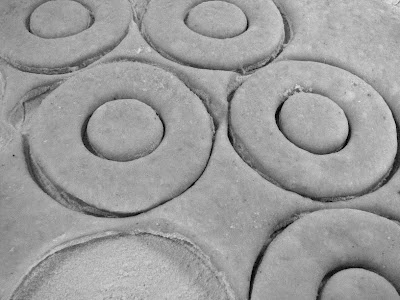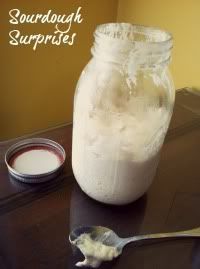The October 2010 Daring Bakers challenge was hosted by Lori of
Butter Me Up. Lori chose to challenge DBers to make doughnuts. She used several sources for her recipes including Alton Brown, Nancy Silverton, Kate Neumann and Epicurious.

Ah, the Donut. Or Doughnut. That bane of the health conscious, foe of waistlines and hips, and destroyer of willpower...
Would it be an understatement that even though I try to shun that poor, sweet thing called "donut", I was giddy with anticipation? When I saw the reveal for this month's challenge, even though I'm hugely fond of Alton Brown and Nancy Silverton, I over-zealously thought of all the bookmarks for donuts (or doughnuts) that I've added to my arsenal this year. Added, and haven't made, mind you. As our challenge was not to use any specific recipe, but to "just make doughnuts!", I immediately, given my preoccupation with all things sourdough, I knew I'd have to try a sourdough version - and figured, while I was at it, maybe I'd veganize it to boot. But more on that later. First, I'd like to divulge the success of my first attempt at making (and eating) baked doughnuts.
 The lightest, fluffiest dough - easy to roll on a floured towel.
The lightest, fluffiest dough - easy to roll on a floured towel.
Doughnuts indeed have worldwide appeal. They are found in various forms all over the planet, from savory Indian versions, to red bean or sesame filled versions made of rice in South Korea. Personally, I do hear the siren call of the doughnut, particularly while visiting my Parents, and am able to visit the rural Amish bakeries on Saturday mornings. Tiny shops pop up to life once a week around the idyllic, Wisconsin countryside: "pole shed" buildings most of the time, that once entered rob you of any thought of self-control. There are all types of doughnuts under these roofs, raised and glazed and filled and drizzled, and waiting on baker's trays just calling your name. (These shops always have other baked goods, berry and fruit pies coming from steaming wood fired ovens, bags full of homemade dried eggs noodles in various thicknesses and often, home preserves of various sorts.) It's easy to get carried away, and spend the rest of the morning, tearing off bite sized pieces of full fledged adult sized doughnuts, so as not to really know how much you are consuming.
When I finally settled on making doughnuts of my own, I figured, I would of course make a baked version, and then finally settled on
this one from the Chabad.org website. It is a gem of a recipe, and has warm, delicious doughnuts on your table (and gracing your waistline) in about 2 hours. I opted for the creamy, buttery glaze since I was so virtuous in the baking and not frying of these lovelies, and that, friends, was the proper choice.


For the recipe as listed, my yield was 8 full size doughnuts and about 30 donut holes. I used two sizes of biscuit cutters to form my doughnuts (a 3 7/16 inch cutter for the doughnut and a 1 1/2 inch cutter for the holes). I did re-roll my scraps, and made additional holes. After all, when you have bite sized bits, it's so much easier to guiltlessly eat them. They are so small! You hardly know that they are being ingested!
The dough is so soft and easy to work with, the gentlest amount of rolling on a heavily floured towel prevents any sticking. And, it's true, a homemade and baked doughnut has got to be better for you than any Dunkin', Horton, or Amish made substitute.


- 2 packages dry yeast (about 35 grams of fresh, or 2 scant Tablespoons
- 1/4 cup warm water
- 1-1/2 cups milk, scalded and cooled
- 1/2 cup sugar
- 1 teaspoon salt
- 1 teaspoon nutmeg
- 1/4 teaspoon cinnamon (optional)
- 2 eggs
- 1/3 cup shortening (I used Spectrum Organic)
- 4-1/2 cups flour
In a large mixer bowl, dissolve yeast in warm water. Add milk, sugar, salt, spice, eggs, shortening and 2 cups flour. Blend 1/2 minute at medium speed, scraping bowl occasionally. Stir in remaining flour until smooth, scraping sides of bowl. Cover. Let rise in warm place until double (50 to 60 minutes).
Turn dough onto well-floured cloth-covered board; roll around lightly to coat with flour. Dough will be soft to handle.
With floured, stockinette-covered rolling pin, gently roll dough about ½ inch thick. Cut with floured 2-1/2 inch doughnut cutter. Lift doughnuts carefully with spatula and place 2 inches apart on greased cookie sheet. Brush doughnuts with melted butter. Cover; let rise until double (about 20 minutes).
Heat oven to 420° F. Bake 8 to 10 minutes or until golden. Immediately brush with melted margarine or butter and shake in Cinnamon Sugar or spread with Creamy Glaze (recipes below). Makes 1-1/2 to 2 dozen doughnuts.
Toppings (best if made while doughnuts are baking):
Cinnamon Sugar
- 1/2 cup sugar and
- 1/2 teaspoon cinnamon
Creamy Glaze:
Melt 1/3 cup butter. Blend in 2 cups powdered sugar and 1-1/2 teaspoons vanilla. Stir in 4 to 6 Tablespoons water, one at a time, until melted glaze is of proper consistency.
Note (from Chabad.org): It's true; the dough does not have to be kneaded. This gives an extremely light and loose dough. I did not use a cloth or stockinette; a floured surface and floured rolling pin were sufficient. With the dough so light, a feather touch rolls it out. Nonetheless, the doughnuts rolled out from the "scraps" of dough did come out thicker and nicer. I did not brush them with butter either before or after baking, with no apparent harm (since I was using glaze instead of cinnamon sugar).

I also did not brush with butter, since I used the creamy glaze. These were best right out of the oven, but were still good a few hours later. I think it'd be best to serve these when you have a houseful of people to please for breakfast some winter morning. They were not quite as good after they cooled, but it didn't stop me from continuing to eat them...
Hot, they were light and amazing like a properly fried doughnut, sans any guilt - especially when eating a number of the donut holes:

Later in the month, I decided that I HAD to try a vegan and sourdough version. I based my effort on
this doughnut from Apricosa. Most impressive, was that my dough actually rose, albeit very slowly. I let the dough stand for 18 hours or longer before rolling out into doughnuts, and let the doughnuts rise about 8 hours before trying to bake them. I used soy milk, and flax instead of eggs, and 1/4 c. sourdough starter for the leavening agent. I was so hoping I'd bite into a hot doughnut and be so smitten and overjoyed that I'd go into business for myself hawking vegan sourdough baked donuts. Not so much. They were edible, but not "donutty" enough for me. Pleasantly sour and very breadlike, I dipped them in soy milk and then a vanilla sugar topping before my taste test. Just all right, nothing to write home about. But, as is the case of easily devoured, bite-sized donut holes, my visiting Mom and I ate our share (and then decided to break out the non-vegan creamy glaze that was leftover from the last batch) and try some more. Even my Husband ate several before declaring that the last batch was way better. I know. I tried.


And so a very satisfying and fun Daring Baker month has once again come to a close. As the wind roars and October has decided to behave more like himself, I'm thinking of making more doughnuts (of the baked variety), and even trying to get a sourdough version to work to my specifications for a doughnut: sweet, soft, and a bit bad for me - like most good things in the dessert world.
Thank you to Lori for a very good choice in Daring Baker challenges! This month, I learned a bit more about baking and dough, happened to find a creamy glaze worth daydreaming about, and am still feeling rather virtuous in my pursuits of healthy dessertdom. All, undeniably priceless.












